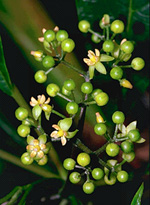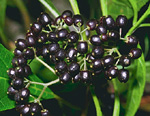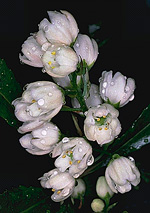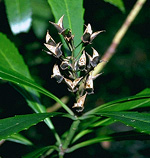 |
This moderate-sized family is almost cosmopolitan. In Australia, most species occur in temperate and subtropical wet forests and rainforests, in Queensland, New South Wales and Tasmania.
Characteristic features of the family Grossulariaceae in Australia include: - shrubs or small trees with opposite or alternate, simple leaves often with glandular teeth
- flowers usually white but often showy, in panicles, often with a saucer- or cup-shaped hypanthium
- sepals usually 5, more or less fused; petals 5, free; stamens 10
- ovary superior to inferior, sometimes of nearly free carpels, with 2-5 free styles
- fruit a capsule, occasionally comprising 4 free follicles
Description
Evergreen, deciduous or semi-deciduous trees or shrubs. Vegetative reproduction rarely by layering. Stems unarmed or rarely with thorns or spines arising from the leaf axils. Internal secretions not obvious. Plants glabrous, or with simple, glandular or non-glandular, unicellular hairs. Leaves alternate and spiral, or opposite, or apparently whorled, petiolate. Stipules absent. Lamina simple or rarely once compound, ternate, symmetric, pinnatifid or pinnatisect or palmatifid or palmatisect; lamina/leaflets lanceolate, ovate, elliptic, oblanceolate or obovate; base cuneate or attenuate; margins entire, crenate, dentate or serrate, ±flat; venation pinnate, or palmate, with the midrib conspicuous, and the tertiary venation reticulate or not; surfaces punctate or not; herbaceous or leathery; distinctive odour absent or aromatic. Domatia absent or consisting of pits or pockets in the vein angles. Male and female flowers occurring on separate plants, or with all the flowers bisexual. Inflorescences terminal or axillary, consisting of racemes or cymes. Bracts present or absent. Flowers stalked. Floral disc present; nectaries present on the disc. Free hypanthium ±present. Perianth regular, of 2 dissimilar whorls. Calyx segments free or fused, with 4–7 sepals or lobes, imbricate in bud; calyx cup-shaped, bell-shaped or urn-shaped, herbaceous. Corolla segments free or fused, with 4–7 petals or lobes, alternating with the sepals or calyx lobes, imbricate or valvate in bud; corolla wheel-shaped or bell-shaped, white, cream, yellow, pink or green, without contrasting markings, membranous; claws present or absent; lobes ±entire or notched, emarginate, bifid or bilobed. Fertile stamens 4 or 5, opposite to the sepals or calyx lobes, free of the corolla, free of the ovary and style, distinct from each other, all ±equal. Anthers basifixed, not versatile, opening inwards by longitudinal slits, 2-celled. Ovary superior and sessile, or part-inferior, or inferior. Carpels 2–5, fused; ovary with 1–5 locules. Style terminal, single and unbranched or single and branched above. Ovules 1–numerous per locule, sessile; placentation parietal or axile. Fruit a dry, dehiscent loculicidal or valvular capsule or a fleshy, indehiscent berry; the perianth on the maturing fruit deciduous or dry and persistent. Disseminule macro-surface featureless or winged; micro-surface ±smooth, yellow, red, green, brown or black, without contrasting markings, or conspicuously patterned, glossy. Seeds 1–numerous per fruit. Aril absent. Cotyledons 2. Embryo straight.
(Note: this description has been generated from the coded data compiled for the key. Any errors in the key data will be reflected in the descriptions.)
A treatment of the family Grossulariaceae has not yet been published in the Flora of Australia. It will appear in Volume 10.
Australian genera of Grossulariaceae (as recognised for the Flora of Australia)
* = all species introduced
Abrophyllum
Anopterus
Argophyllum
Corokia
Cuttsia
*Escallonia
Polyosma
Quintinia
*Ribes
Tetracarpaea

|
  |

Abrophyllum ornans (flowers)
Photo: D.Jones © D.Jones

Abrophyllum ornans (fruits)
Photo: D.Jones © D.Jones

Anopterus glandulosus (flowers)
Photo: M.Fagg © ANBG

Anopterus glandulosus (fruits)
Photo: H.Nicholson © H. & N. Nicholson

|

| |